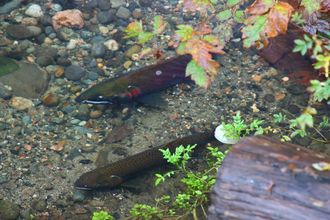
Fall is the time when salmon return to local streams to spawn. Bellevue has over 80 miles of streams, many of them habitat for chinook, coho and sockeye salmon.
For more information on Bellevue's salmon population:
To request a report from a previous year, email EMP@bellevuewa.gov.
If you would like to be a salmon watcher, contact Bellevue’s Stream Team in August at streamteam@bellevuewa.gov or 425-452-5200. If training dates have passed, you can ask to be on the list for next year.
Salmon Life Cycle
Salmon born in a creek such as Kelsey make their way to the Pacific Ocean by swimming through Mercer Slough to Lake Washington, on to Lake Union via the Lake Washington Ship Canal, through the locks into Puget Sound, and eventually out to the ocean. They stay in the ocean for two to four years and then return in the fall months to the stream of their birth to spawn (deposit and fertilize eggs).
Salmon Needs
Salmon are fragile and sensitive to water conditions. This sensitivity makes them excellent indicators of water pollution, which impacts people as well as fish. Salmon need certain conditions to be healthy:
- Streamside vegetation and stable stream flows.
- Cool, clean water with enough oxygen.
- Clean, loose gravel to protect salmon eggs from predators and allow water to flow through the eggs for oxygen.
Where to See Salmon in Bellevue
Many salmon sightings are on private property in Bellevue and inaccessible. The best public places to spot salmon include:
- Kelsey Creek at the southeast side of 140th Avenue Northeast and Bel-Red Road, upstream of the culvert of 140th.
- Fish ladder at 118th Avenue Southeast, just south of Southeast Eighth Street. Look for the blue Mercer Slough signs.
- Kelsey Creek Farm - West Tributary adjacent to main parking. Fish have been seen all along the stream, from the parking lot to the pioneer cabin.
- Kelsey Creek Farm - over the hill on the east side of the farm - stand on the footbridge to view or go to a stream viewing area, down the trail to the south.
If you see a dead salmon in a stream, it’s important not to remove the carcass. Alive or dead, salmon bring beneficial minerals and nutrients back from the ocean, which is good for streams. Salmon Seeson
